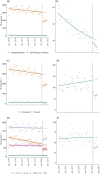The impact of the COVID-19 pandemic on TB notifications in Ukraine in 2020
- PMID: 39021447
- PMCID: PMC11249659
- DOI: 10.5588/ijtldopen.24.0194
The impact of the COVID-19 pandemic on TB notifications in Ukraine in 2020
Abstract
Background: We assessed the impact of the COVID-19 pandemic on TB notifications in Ukraine, stratified by multiple subgroups.
Design/methods: We analyzed data from Ukraine's National TB Program from January 2015 to December 2020 using interrupted time series models. We compared observed cases to counterfactual estimated cases had the pandemic not occurred and estimated trends through December 2020 nationally and by various demographics. We compared the proportions of individuals who underwent drug susceptibility testing (DST) in February 2020 and April 2020 to assess the pandemic impact on drug resistance testing.
Results: In April 2020, there were 39% (95% CI 36-42) fewer TB notifications than the estimated counterfactual (3,060 estimated; 95% CI 2,918-3,202; 1,872 observed). We observed a greater decrease in notifications among refugees/migrants compared with non-refugees/migrants (64%, 95% CI 60-67 vs. 39%, 95% CI 36-42), and individuals aged <15 years compared with those aged ≥15 years (60%, 95% CI 57-64 vs. 38%, 95% CI 36-41). We also observed a decrease in the proportion of individuals receiving DST for several drugs.
Conclusions: These findings underscore the challenges to TB prevention and care during disruption and may be generalizable to the current wartime situation, especially considering the substantial increase in refugees within and leaving Ukraine.
Contexte: Nous avons évalué l'impact de la pandémie de COVID-19 sur les notifications de TB en Ukraine, stratifiées en plusieurs sous-groupes.
Conception/méthodes: Nous avons analysé les données du Programme national de lutte contre la TB de l'Ukraine de janvier 2015 à décembre 2020 à l'aide de modèles de séries chronologiques interrompues. Nous avons comparé les cas observés aux cas contrefactuels estimés si la pandémie n'avait pas eu lieu et les tendances estimées jusqu'en décembre 2020 à l'échelle nationale et selon divers groupes démographiques. Nous avons comparé les proportions de personnes ayant subi un test de sensibilité aux médicaments (DST) en février 2020 et avril 2020 pour évaluer l'impact de la pandémie sur les tests de résistance aux médicaments.
Résultats: En avril 2020, il y avait 39% (IC à 95% 36–42) de notifications de TB de moins que le contrefactuel estimé (3 060 estimés ; IC à 95% 2 918–3 202 ; 1 872 observés). Nous avons observé une plus grande diminution des notifications chez les réfugiés/migrants par rapport aux non-réfugiés/migrants (64%, IC à 95% 60–67 contre 39%, IC à 95% 36–42), et les personnes âgées de <15 ans par rapport à celles âgées de ≥15 ans (60% ; IC à 95% 57–64 contre 38% ; IC à 95% 36–41). Nous avons également observé une diminution de la proportion de personnes recevant le DST pour plusieurs médicaments.
Conclusions: Ces résultats soulignent les défis de la prévention et des soins de la TB pendant les perturbations et peuvent être généralisés à la situation actuelle en temps de guerre, en particulier compte tenu de l'augmentation substantielle du nombre de réfugiés à l'intérieur et à l'extérieur de l'Ukraine.
Keywords: control program; drug resistance; epidemiology; modelling; prevention; tuberculosis.
© 2024 The Authors.
Figures


References
-
- World Health Organization . Global tuberculosis report, 2021. Geneva, Switzerland: WHO, 2021.
-
- Stop TB Partnership . The potential impact of the COVID-19 response on tuberculosis in high-burden countries: a modelling analysis. 2020.
-
- World Health Organization . Global tuberculosis report, 2020. Geneva, Switzerland: WHO, 2020.
Grants and funding
LinkOut - more resources
Full Text Sources
Miscellaneous
